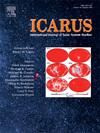The origin of the high-TiO2 region near the Manilius and Hyginus craters within Mare Vaporum on the Moon
IF 2.5
2区 物理与天体物理
Q2 ASTRONOMY & ASTROPHYSICS
引用次数: 0
Abstract
Finding and utilizing the resources of the Moon is becoming more important with the prospect of human outposts on our planets satellite. When selecting a landing site, ilmenite, the main carrier of TiO on the Moon, is a key target due to its potential for oxygen extraction and because ilmenite traps He most effectively among the lunar minerals. The large dark mantle deposit in Mare Vaporum is one of the TiO richest areas on the Moon. Furthermore, dark haloed impact craters around Manilius crater within the Mare Vaporum region are surrounded by ejecta material with increased TiO abundance, making the larger region an important target for further scrutiny. In this work, we study this region to (1) assess the distribution of potential resources, (2) determine the formation mechanisms and (3) evaluate the suitability for establishing a human outpost. We use spectral parameters in the near-infrared wavelength range to determine the abundances of the major elements as well as glasses. Dark mantle deposits show higher glass and TiO abundances, while the surface surrounding the dark haloed impact craters only show increased TiO. From a resource perspective, dark mantle deposits are of special interest because He bubbles form in the glasses, which require less energy to be extracted. Additionally, we use polarimetric observations to infer the relative grain sizes of the study area. It shows that the regolith of the region of interest is more coarsely grained, which in turn is characteristic for fresher or glassy material. Finally, digital elevation models show that the dark mantle deposit is characterized by steeper slopes compared to the terrain surrounding the dark haloed impact craters, which makes it challenging to land directly in the dark mantle deposit. After formation of the dark mantle deposits, ejecta and residue lead to a degradation of the north-western part of the dark mantle deposit, contributing to the U-shape observed today. The Rima Hyginus and Hyginus crater were formed by volcanic processes.
求助全文
约1分钟内获得全文
求助全文
来源期刊

Icarus
地学天文-天文与天体物理
CiteScore
6.30
自引率
18.80%
发文量
356
审稿时长
2-4 weeks
期刊介绍:
Icarus is devoted to the publication of original contributions in the field of Solar System studies. Manuscripts reporting the results of new research - observational, experimental, or theoretical - concerning the astronomy, geology, meteorology, physics, chemistry, biology, and other scientific aspects of our Solar System or extrasolar systems are welcome. The journal generally does not publish papers devoted exclusively to the Sun, the Earth, celestial mechanics, meteoritics, or astrophysics. Icarus does not publish papers that provide "improved" versions of Bode''s law, or other numerical relations, without a sound physical basis. Icarus does not publish meeting announcements or general notices. Reviews, historical papers, and manuscripts describing spacecraft instrumentation may be considered, but only with prior approval of the editor. An entire issue of the journal is occasionally devoted to a single subject, usually arising from a conference on the same topic. The language of publication is English. American or British usage is accepted, but not a mixture of these.
 求助内容:
求助内容: 应助结果提醒方式:
应助结果提醒方式:


